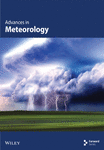The Impact of Space Weather on Ultraviolet Radiation at Mid Latitudes
Abstract
Solar ultraviolet (UV) radiation plays a crucial role in various environmental, atmospheric, and industrial applications, despite covering only a small portion of the electromagnetic solar radiation. The distribution of UV radiation reaching the Earth’s surface is influenced by multiple environmental, atmospheric, and astronomical factors, some of which require further investigation. The aim of this study is to explore the potential impact of cosmic rays and space weather parameters on solar UV radiation. To achieve this, the study utilized solar UV data collected from the King Abdulaziz City for Science and Technology (KACST) radiometric station, situated in central Saudi Arabia (latitude 24 43, longitude 46 40, altitude 613 m) for the period 2015–2021, along with space weather parameters. These parameters include solar radio flux at 10.7 cm (F10.7 cm) and sunspot number (SSN), as well as cosmic ray data from the Oulu neutron monitor for the same period as the UV data. The study conducted correlation analyses between the time series UV data and the considered parameters, revealing mutual relationships between these variables. UV radiation demonstrated a positive correlation with the SSN and F10.7 cm radio flux while showing a significant anticorrelation with the CR data. Furthermore, the mean daily time series of the variables underwent power spectral analyses to identify potential common periodicities. The spectral analyses showed several common periodicities in all the variables considered, such as ~410, 172, 165, and 66 days. Based on the correlations and spectral results, the study suggests that solar signals could have a direct or indirect impact on the observed solar UV radiation at a specific site. This finding has significant implications for our understanding of the factors that affect UV radiation.
1. Introduction
Solar ultraviolet (UV) radiation, which spans between 290 and 400 nm of the electromagnetic solar radiation reaching the Earth’s surface, is essential for various environmental, atmospheric, biological, and industrial applications (e.g., [1–5]). UV radiation contributes significantly to the atmosphere’s vertical, thermal, and electronic structure, as well as atmospheric chemistry, through ionization, dissociation, and excitation processes [6]. The amount of UV radiation reaching the Earth’s surface is influenced by astronomical and geographical factors, including solar zenith angle, earth–sun distance, latitude, and altitude. During its propagation through the Earth’s atmosphere, UV radiation undergoes scattering and absorption processes due to atmospheric and environmental factors such as clouds and aerosols [7–14].
One area of interest for scientists is the potential relationship between space weather parameters, cosmic rays, and UV radiation. Space weather activities have been shown to influence the Earth’s environment, and scientists from various fields have been exploring this relationship [15–22].
In this study, we aimed to investigate whether changes in space weather parameters and cosmic rays could lead to measurable changes in UV radiation. The study utilized correlation and Fourier transform analyses to explore this relationship. Although UV radiation is influenced by multiple factors, including environmental, atmospheric, and astronomical ones, the potential impact of space weather activities on UV radiation represents a fascinating area of ongoing research.
2. Materials and Methods
2.1. Data
The experimental dataset encompasses UV radiation measurements, cosmic ray observations, and space weather parameters. UV radiation data were collected using a SKU 421 radiometer [23] installed at the King Abdulaziz City for Science and Technology (KACST) campus in Riyadh, Saudi Arabia (24.43°N, 46.40°E). The instrument, designed to measure UVA radiation (315–400 nm), recorded measurements at 1-minute interval. This spectral range represents the predominant UV component reaching Earth’s surface, making it appropriate for our investigation. The high-resolution data were subsequently integrated to generate hourly values following established protocols [6].
To ensure data quality, UV data was limited to sun elevation angles greater than 10° and excluded if the measured value exceeded the corresponding extraterrestrial radiation (UV0) at the observation site (e.g., [9]). Extraterrestrial UV radiation was calculated using standard formulas (e.g., [11]).
Cosmic ray data were obtained from the Oulu Neutron Monitor (65.05°N, 0.8 GV) during the UV detector’s operational period. While the monitoring station’s geomagnetic cutoff rigidity differs from our measurement site (24.43°N, ~14.4 GV), extensive research has established that geographic location does not constrain long-term correlation analyses between cosmic rays and atmospheric parameters. Multiple investigations have validated the utilization of established cosmic ray monitoring stations for studying atmospheric and meteorological correlations across diverse geographic locations, with this location-independence verified through comprehensive analyses of the global neutron monitor network (e.g., [17, 18, 19–20, 22, 24]).
Space weather parameters were acquired from multiple sources: NOAA’s Space Weather Prediction Center, the National Geophysical Data Center, and the GSFC/SPDF OMNIWeb interface for solar indices and F10.7 cm flux data. All variables in this investigation were analyzed using daily averages derived from hourly measurements.
2.2. Methodology
The study aimed to investigate the relationship between UV radiation, space weather, and CR data using the least squares method and related statistical tests. The Pearson correlation coefficient was employed to measure the strength of the linear relationship between the considered variables. To determine the periodicity of selected variables during the study period, Fourier transform analysis was conducted. The power spectrum calculation method used in this study was similar to those proposed in previous studies, including Mavromichalaki et al. [25], Kudela and Mavromichalaki [26], Maghrabi and Kudela [18], and Maghrabi et al. [20].
3. Results and Discussions
3.1. Correlation Analyses’ Results
Figure 1 displays the daily mean values of UV radiation and the variables considered during the study period. The graph reveals that UV radiation is subject to seasonal fluctuations, with its highest values observed during summer and the lowest values during winter. The sunspot number (SSN) and radio flux show a declining trend, which is typical during the decline phase of the solar cycle. In contrast, cosmic ray neutrons increased during this period, as the Sun’s magnetic field weakened in influence. Despite these trends, all variables considered in this study fall within the expected range of values during the research period.

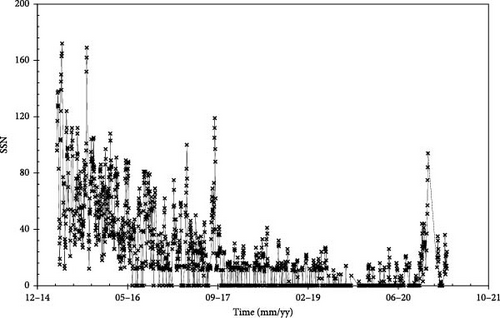
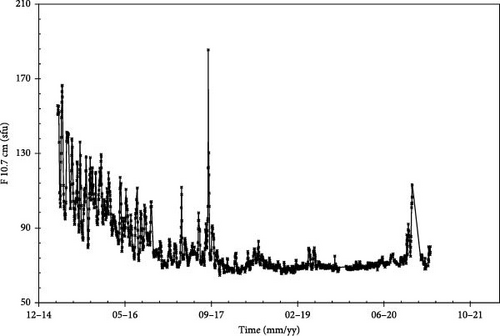
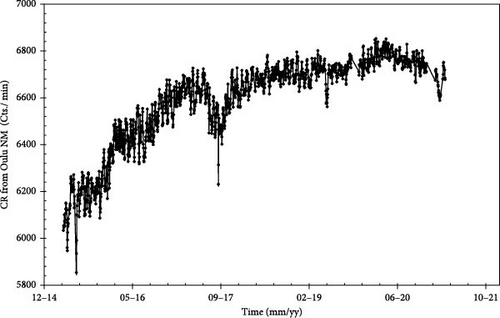
Figure 2 presents the relationship between the daily average of UV radiation and the selected variables during the study period. Although the data exhibit some scatter, the plot indicates that UV radiation had an inverse correlation with CR and varied levels of correlation with the other variables.

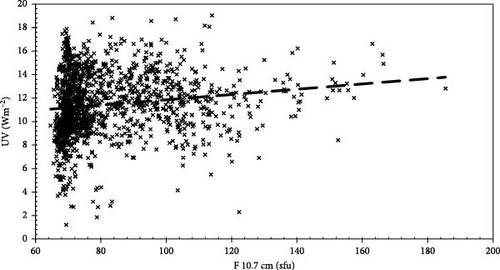

The results show that UV radiation is significantly anticorrelated with CRs, with a correlation coefficient of 0.44. Additionally, it is positively correlated with SSN and radio flux at 10.7 cm, with correlation coefficients of 0.11 and 0.15, respectively. Although the correlation coefficients for the relationships between UV radiation and the considered variables are relatively low, the results were statistically confirmed and showed nonzero relationships. Several factors may affect these correlations, including geometrical factors, meteorological conditions, environmental factors, and atmospheric parameters that may impact UV radiation (e.g., [1, 2, 8, 11, 14]).
3.2. Power Spectral Results
Power spectral analysis was performed on the daily measurements of UV radiation, cosmic rays, and space weather parameters using Fast Fourier Transform (FFT) with Welch window method. Data gaps were addressed through neighbor-day extrapolation for intervals shorter than 4 days, while longer gaps were processed using spectral techniques for unevenly spaced data, maintaining spectral integrity [25, 26].
To resolve local quasi-periodicities near dominant frequency ranges, minimum variance technique was employed [20, 24, 27]. This approach involved selecting frequency windows around prominent peaks, detrending the data, and applying Fourier filtering within the selected intervals. The analysis utilized a cutoff frequency of 0.004 day⁻1 to isolate shorter-term variations from the annual cycle, which dominated the lower frequency range. The significance of the obtained periodicity was calculated using the peak-based critical limit method. This type of test aims to reject the null hypothesis by assuming either a white noise signal (AR (1) = 0.0) or a red noise signal (AR (1) > 0.0). In this study, the peaks were considered significant if their confidence level was above 99%, as established in previous studies, such as Kudela and Mavromichalaki [26] and Maghrabi and Kudela [18]. The resultant Lomb periodogram (Figure 3) displays UV radiation data across two frequency ranges, revealing multiple statistically significant peaks exceeding the 99% confidence threshold, characterized by varying amplitudes and intensities.
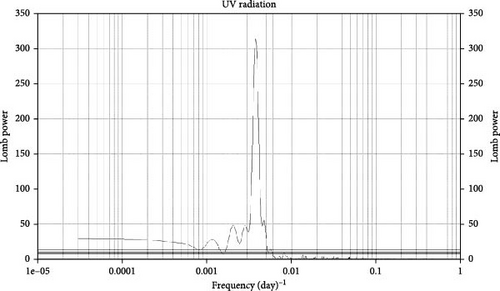
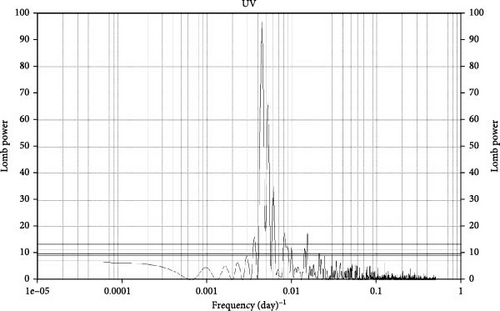
Figure 3a displays the Lomb periodogram of the UV radiation data for two frequency ranges, with the most prominent peaks observed at 432 days (1.2 years), 268 days, 190–210 days, and 165 days. Other noteworthy peaks identified in Figure 3b include 157, 114–108, and 64–67 days.
In contrast, Figure 4 presents the Lomb periodogram for the SSN, cosmic rays from Oulu NM, and F10.7 cm radio flux.
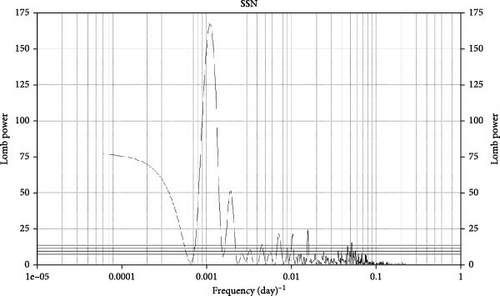

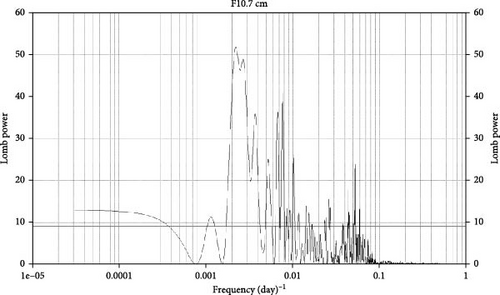
The SSN spectrum exhibited peaks at 434 days (~1.2 years), 321 days, 227 days, 140 days, 109–112 days, 67 days, and 25 days. Similarly, the spectrum of the solar radio flux F10.7 presented significant peaks, including 410 days (~1.12 years), 321 days, 224 days, 187 days, 162–172 days, 132–126 days, 122–117 days, 72–69 days, and 22–17 days. In contrast, the cosmic rays data spectrum displayed peaks at 415 days (~1.12 years), 315 days, 221 days, 170 days, 127 days, and 90 days.
These periodicities have been reported previously by several investigators [28–35].
3.3. Discussions
The results presented above indicate nonzero correlations between the time series of UV radiation data and the considered variables, which were found to be statistically significant. UV radiation was observed to decrease as CR increases, whereas it increases as radio flux and sunspot increase. Power spectral analyses revealed several periodicities in the UV spectra, with some expected to be of extraterrestrial origin.
While the exact mechanism explaining these relationships is not yet clear, helio-climatological investigations conducted over the last two decades have shown that solar activity and its disturbances may directly or indirectly affect the environment, atmospheric, and climatic changes, including variations in UV radiation [36, 37]. Solar disturbances, also, affect the interplanetary medium, which modulates primary cosmic rays in the heliosphere and their rate at the top of the atmosphere, leading to variations in the ionization of the atmosphere and subsequent changes in the physical and chemical properties of the atmosphere. These changes can affect the amount of UV radiation during its propagation through the Earth’s atmosphere [38–43].
To investigate this assumption, Figure 5 from Maghrabi and Kudela (2019) shows a positive correlation between CR and atmospheric aerosols measurements obtained at Riyadh for a 16-year period, indicating that cosmic ray particles are one of the main sources of aerosols induced in the atmosphere.
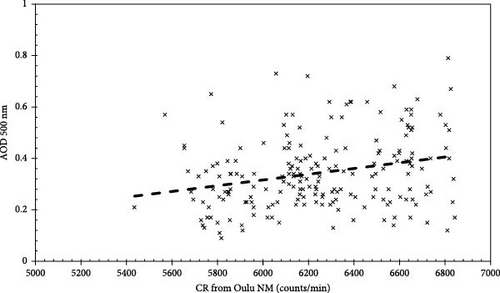
Although the exact mechanism explaining the final fate of the condensed nuclei is not yet clear, cosmic rays have been found to play influential roles in aerosol formations and concentrations, as well as their effect on the atmospheric chemistry [43–45]. These aerosols, in turn, can affect UV radiation as they propagate through the atmosphere via complicated scattering and absorption processes [46, 47].
Figure 6 presents a 1-year dataset showing the relationship between UV radiation and atmospheric aerosols from the study site, indicating that an increase in atmospheric aerosols reduces solar UV radiation. However, there is some scatter in this relationship, which may be attributed to several factors, including the amount, chemical composition, and physical characteristics of the aerosols, as well as prevailing atmospheric conditions and other meteorological factors.

Several investigations have confirmed the relationship between UV radiation and the QBO, which is associated with solar activity cycles. Zerefos et al. [48] found that UV solar irradiances at Thessaloniki, Greece, are in phase with the QBO. Udelhofen et al. [49] observed that changes in UV erythemal exposure are associated with phases of the QBO and solar activity cycles using TOMS observations. Cabrera and Fuenzaliada [50] reported evidence of a relationship between the QBO and UV solar irradiance at Santiago, Chile. More recently, Elias [51] found a significant correlation between the QBO and UV radiation in the southern hemisphere. Hood [52] reported that the QBO modulates the solar cycle variation of tropical stratospheric ozone and temperature. Krzyścin and Rajewska-Więch [53] observed a statistically significant relationship between the QBO and UV radiation over Poland. However, it remains challenging to assess which factors precisely affect UV radiation in the present context. Overall, the results provide insight into the possible role of solar activity in climate change issues.
4. Conclusions
This study utilized UV radiation data spanning from 2015 to 2021 to investigate their relationships with various space weather variables, including solar radio flux, SSN, and cosmic rays. The data underwent correlation and power spectral analyses, leading to several conclusions. Firstly, there is a significant anticorrelation between the time series of UV and cosmic rays, indicating that as the cosmic ray flux increases, UV solar radiation decreases. Secondly, the solar radio flux and SSN demonstrated a nonzero positive relationship with UV solar radiation. Thirdly, spectral analysis revealed the presence of common signals in the spectra of the variables, including quasi-periodicities of ~410, 172, 165, and 66 days.
These findings suggest a possible connection between variations in space weather parameters and cosmic rays and UV solar radiation observed on the ground at the specific position analyzed in this study. The results contribute to our understanding of the factors that affect UV radiation and may provide opportunities for further investigation. However, the exact mechanism of the relationship between UV radiation and the considered variables remains unclear.
One possible explanation is that solar eruptive processes affect the interplanetary medium, which then modulates the primary CR particles. These particles are the main sources of atmospheric ionization, and the condensed nuclei produced from such ionizations may play a role in aerosol formation and concentration. Atmospheric aerosols can affect UV radiation through scattering and absorption processes. While the findings presented in this study are preliminary, they offer valuable insights into the effects of solar activity on Earth’s climate, and further research in this area is recommended.
Ethics Statement
The authors have nothing to report.
Consent
The authors have nothing to report.
Conflicts of Interest
The authors declare no conflicts of interest.
Author Contributions
All the work presented in this manuscript was conducted by the author. These include material preparation, data collection and analysis, and the final draft of the manuscript.
Funding
We, the authors of the manuscript entitled: The Impact of Space Weather on Ultraviolet Radiation at Mid-Latitudes “we have received no fund from any organization nor any person for this project”. We, the authors have no relationships with other people or organizations that could inappropriately influence (bias) our work.
Acknowledgments
We would like to thank the King Abdulaziz City for Science and Technology (KACST) for supporting this work. The solar indices, F10.7 cm, were obtained from the GSFC/SPDF OMNIWeb interface at https://omniweb.gsfc.nasa.gov. We acknowledge the SPDF OMNIWeb database as the source of data used in this research study. The cosmic ray data for Oulu neutron monitor were obtained from http://cosmicrays.oulu.fi/.
Open Research
Data Availability Statement
The datasets analysed during the current study are not publicly available due the organization (KACST) policies but are available from the corresponding author on reasonable request.
No code was used in this study the analyses were carried out using the commercial software.



